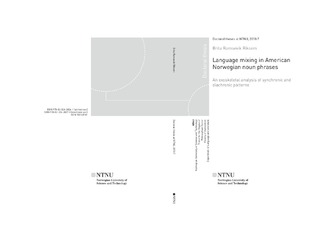| dc.contributor.advisor | Åfarli, Tor Anders | |
| dc.contributor.advisor | Lohndal, Terje | |
| dc.contributor.author | Riksem, Brita Ramsevik | |
| dc.date.accessioned | 2018-02-15T08:45:17Z | |
| dc.date.available | 2018-02-15T08:45:17Z | |
| dc.date.issued | 2018 | |
| dc.identifier.isbn | 978-82-326-2827-8 | |
| dc.identifier.issn | 1503-8181 | |
| dc.identifier.uri | http://hdl.handle.net/11250/2484883 | |
| dc.description.abstract | The overall objective of the current dissertation is to investigate the morphosyntax of noun phrases in the heritage language American Norwegian (AmNo) that show mixing between English and Norwegian. AmNo was spoken by Norwegian immigrants to America in the years roughly from 1850 to 1920, and has been maintained by some of their descendants. Frequent usage of English items is characteristic of the language. Here I examine AmNo from both a synchronic and diachronic perspective, uncovering a generally consistent and systematic pattern of language mixing. A late-insertion exoskeletal model is employed to provide formal analyses of the observed patterns in the empirical material.
The dissertation contains three articles addressing the issue of language mixing in AmNo noun phrases from different perspectives. The first article presents empirical evidence that favors an exoskeletal model in analyzing language mixing, as compared to a mainstream lexicalist model. The exoskeletal model crucially separates syntactic structures from their phonological realizations. Moreover, realization of functional features is restricted by feature matching, whereas insertion of non-functional terminals is less restrictive. The second and third articles employ such a model in analyzing synchronic and diachronic patterns of language mixing in AmNo noun phrases, respectively. The former exploits data in the recently collected Corpus of American Norwegian Speech and finds a distinct pattern: English noun stems are incorporated into Norwegian structures and provided with Norwegian functional suffixes and determiners. The pattern is successfully analyzed in the late-insertion exoskeletal model. The third article conducts a diachronic investigation of the language mixing pattern in AmNo noun phrases by comparing the recently collected data with material collected by Einar Haugen in the 1930s and 1940s. The categories of number and definiteness are studied in detail and systematic changes are found: Norwegian functional suffixes are occasionally omitted or replaced by English alternatives. This is attributed to structural reanalysis of the AmNo grammar.
In combination, a thorough investigation of mixed AmNo noun phrases is provided, as well as a discussion of the mechanisms of language mixing in general. A late-insertion exoskeletal model is arguably well suited to account for language mixing without exploiting theoretical mechanisms other than those required for the analysis of monolingual speech. Thus, this model can be seen as a null theory of language mixing. | nb_NO |
| dc.language.iso | eng | nb_NO |
| dc.publisher | NTNU | nb_NO |
| dc.relation.ispartofseries | Doctoral theses at NTNU;2018:7 | |
| dc.relation.haspart | Paper 1: Grimstad, Maren B.; Riksem, Brita R.; Lohndal, Terje, & Åfarli, Tor A. Lexicalist vs. exoskeletal approaches to language mixing. | |
| dc.relation.haspart | Paper 2: Riksem, Brita R. Language Mixing in American Norwegian Noun Phrases. | |
| dc.relation.haspart | Paper 3: Riksem, Brita Ramsevik.Language Mixing and Diachronic Change: American Norwegian Noun Phrases Then and Now. Languages 2017 ;Volum 2.(2). | |
| dc.title | Language mixing in American Norwegian noun phrases. An exoskeletal analysis of synchronic and diachronic patterns. | nb_NO |
| dc.type | Doctoral thesis | nb_NO |
| dc.subject.nsi | VDP::Humaniora: 000::Språkvitenskapelige fag: 010 | nb_NO |
| dc.description.localcode | | nb_NO |
